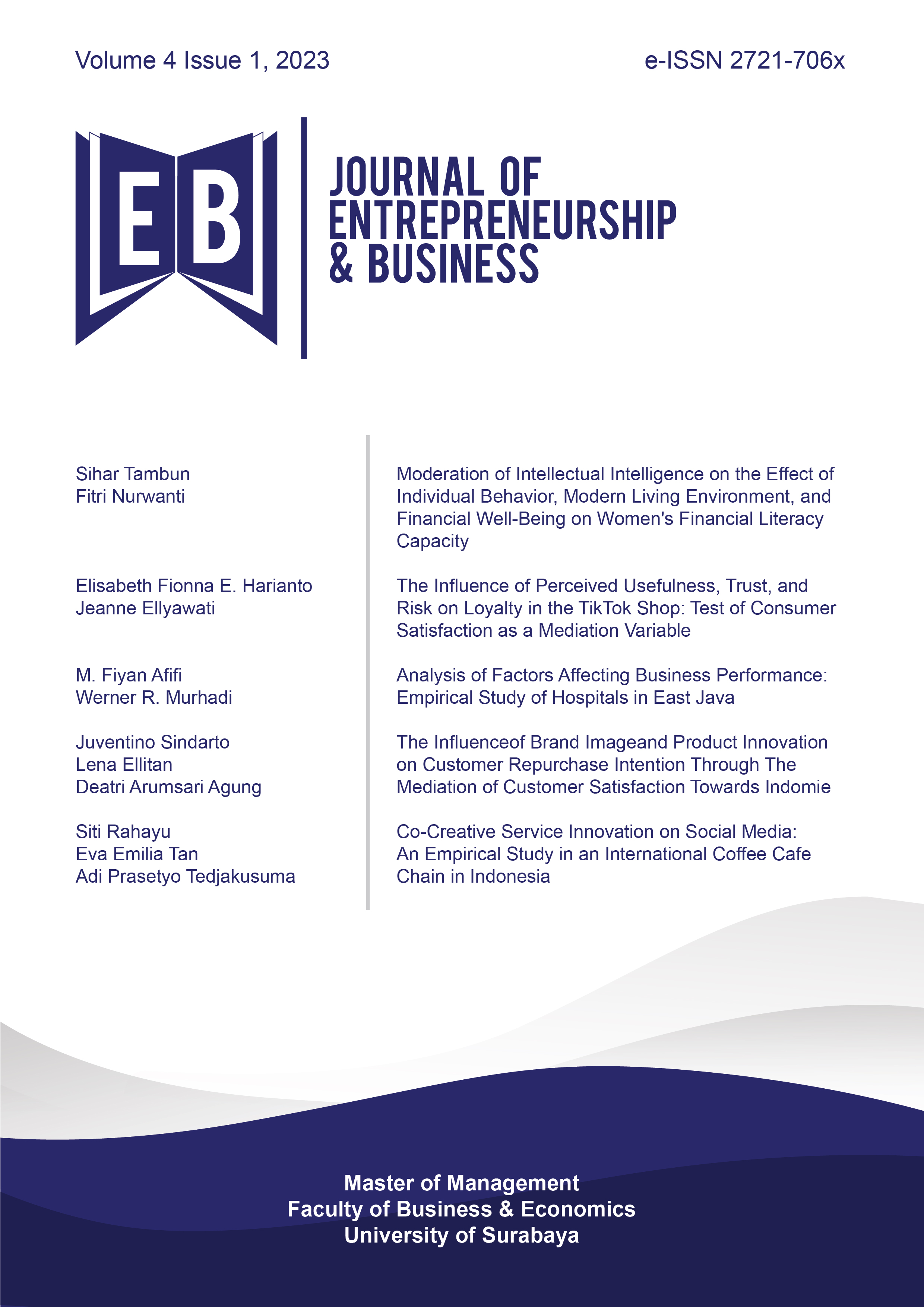Co-Creative Service Innovation on Social Media: An Empirical Study in an International Coffee Cafe Chain in Indonesia
 Abstract Views:
435 times
Abstract Views:
435 times
 PDF Downloads:
480 times
PDF Downloads:
480 times
Abstract
Purpose: This study aims to determine and analyze the effect of consumer innovativeness and attitude toward CCSI on social media, subjective norms, and perceived behavior control on intention to co-create and adoption intention. The object of this study is an international coffee café chain in Indonesia.
Method: This study uses primary data sources by distributing questionnaires online. There are 150 questionnaires used in the data processing. Research data was processed using SEM (Structural Equation Modeling) with IBM SPSS Statistic software and AMOS 22.
Result: The results show that 6 hypotheses are supported and 1 hypothesis is not supported. Consumer innovativeness, subjective norms, and perceived behavior control affect the intention to co-create. Consumer innovativeness, perceived behavioral control, and intention to co-create affect adoption intention. Hypothesis 3: the effect of attitude toward CCSI on social media on intention to co-create is not supported.
Downloads
References
Aal, K., Di Pietro, L., Edvardsson, B., Renzi, M. F., & Guglielmetti Mugion, R. (2016). Innovation in Service Ecosystems. In Journal of Service Management (Vol. 27, Issue 4). https://doi.org/10.1108/josm-02-2015-0044
Ajzen, I. (1991). The theory of planned behavior. Organizational Behavior and Human Decision Processes. Vol. 50 No. 2, pp. 179-211. https://doi.org/10.1016/0749-5978(91)90020-T
Bitner, M. J., & Brown, S. W. (2008). The service imperative. Business Horizons, 51(1), 39–46. https://doi.org/10.1016/j.bushor.2007.09.003
Bruner, G. C., & Kumar, A. (2007). Gadget lovers. Journal of the Academy of Marketing Science, 35(3), 329–339. https://doi.org/10.1007/s11747-007-0051-3
Fishbein, M., & Middlestadt, S. (1995). Noncognitive Effects on Attitude Formation and Change: Fact or Artifact? Journal of Consumer Psychology, 4(2), 181–202. https://doi.org/10.1207/s15327663jcp0402_05
Goldsmith, R. E., & Hofacker, C. F. (1991). Measuring consumer innovativeness. Journal of the Academy of Marketing Science, 19(3), 209–221. https://doi.org/10.1007/BF02726497
Handrich, M., & Heidenreich, S. (2013). The willingness of a customer to co-create innovative, technology-based services: Conceptualisation and measurement. International Journal of Innovation Management, 17(4). https://doi.org/10.1142/S1363919613500114
Kaur, P. (2016). Underpinnings of User Participation in Service Provider–Hosted Online Communities. Service Science, 8(3), 249–262. https://doi.org/10.1287/serv.2016.0136
Kim, E., Ham, S., Yang, I. S., & Choi, J. G. (2013). The roles of attitude, subjective norm, and perceived behavioral control in the formation of consumers’ behavioral intentions to read menu labels in the restaurant industry. International Journal of Hospitality Management, 35, 203–213. https://doi.org/10.1016/j.ijhm.2013.06.008
Kraus, S. J. (1995). Attitudes and the Prediction of Behavior: A Meta-Analysis of the Empirical Literature. Personality and Social Psychology Bulletin, 21(1), 58–75. https://doi.org/10.1177/0146167295211007
Lee, D., Moon, J., Kim, Y. J., & Yi, M. Y. (2015). Antecedents and consequences of mobile phone usability: Linking simplicity and interactivity to satisfaction, trust, and brand loyalty. Information and Management, 52(3), 295–304. https://doi.org/10.1016/j.im.2014.12.001
Lee, H., & Suh, Y. (2016). Who creates value in a user innovation community? A case study of MyStarbucksIdea.com. Online Information Review, 40(2), 170–186. https://doi.org/10.1108/OIR-04-2015-0132
Lee, K. (2016). Travel and IT are the immediate issues for strategic hospitality management. International Journal of Contemporary Hospitality Management.
Maglio, P. P., & Spohrer, J. (2008). Fundamentals of service science. Journal of the Academy of Marketing Science, 36(1), 18–20. https://doi.org/10.1007/s11747-007-0058-9
Moreau, C. P., Lehmann, D. R., & Markman, A. B. (2001). Entrenched knowledge structures and consumer response to new products. Journal of Marketing Research, 38(1), 14–29. https://doi.org/10.1509/jmkr.38.1.14.18836
Nambisan, S. (2002). Designing Virtual Customer Environments for New Product Development: Toward a Theory. Academy of Management Review, 27(3), 392–413. https://doi.org/10.5465/AMR.2002.7389914
Prahalad, C. K., & Ramaswamy, V. (2004). Co-creation experiences: The next practice in value creation. Journal of Interactive Marketing, 18(3), 5–14. https://doi.org/10.1002/dir.20015
Sarmah, B., Kamboj, S. and Rahman, Z. (2017), Co-creation in hotel service innovation using smart phone apps: an empirical study, International Journal of Contemporary Hospitality Management, 29(10), 2647-2667. https://doi.org/10.1108/IJCHM-12-2015-0681
Sarmah, B., Kamboj, S., & Kandampully, J. (2018). Social media and co-creative service innovation: an empirical study. Online Information Review, 42(7), 1146–1179. https://doi.org/10.1108/OIR-03-2017-0079
Sholahuddin, Setyawan, A. A., & Trisnawati, R. (2017). Pengaruh Karakteristik Inovasi terhadap Niat Mengadopsi Solopos Epaper. Prosiding Seminar Nasional Riset Manajemen Dan Bisnis 2017, 2005, 63–84. https://www.apjii.or.id/content/read/39/264/Survei-Internet-APJII-2016
Siqueira, M. S. S., Nascimento, P. O., & Freire, A. P. (2022). Reporting Behaviour of People with Disabilities in relation to the Lack of Accessibility on Government Websites: Analysis in the light of the Theory of Planned Behaviour. Disability, CBR and Inclusive Development, 33(1), 52–68. https://doi.org/10.47985/dcidj.475
Sun, S., Law, R., & Schuckert, M. (2020). Mediating effects of attitude, subjective norms and perceived behavioural control for mobile payment-based hotel reservations. International Journal of Hospitality Management, 84 (June 2019), 102331. https://doi.org/10.1016/j.ijhm.2019.102331
Taylor, S., & Todd, P. (1995). Decomposition and crossover effects in the theory of planned behavior: A study of consumer adoption intentions. International Journal of Research in Marketing, 12(2), 137–155. https://doi.org/10.1016/0167-8116(94)00019-K
Teare, R. (1990). International Journal of Contemporary Hospitality Management. In Marketing Intelligence & Planning (Vol. 8, Issue 5). https://doi.org/10.1108/EUM0000000001079
Uratnik, M. (2016). Interactional service innovation with social media users. Service Science, 8(3), 300–319. https://doi.org/10.1287/serv.2016.0149
Vargo, S. L., & Lusch, R. F. (2011). It’s all B2B...and beyond: Toward a systems perspective of the market. Industrial Marketing Management, 40(2), 181–187. https://doi.org/10.1016/j.indmarman.2010.06.026
Vargo, S. L., Maglio, P. P., & Akaka, M. A. (2008). On value and value co-creation: A service systems and service logic perspective. European Management Journal, 26(3), 145–152. https://doi.org/10.1016/j.emj.2008.04.003
Vermeulen, I. E., & Seegers, D. (2009). Tried and tested: The impact of online hotel reviews on consumer consideration. Tourism Management, 30(1), 123–127. https://doi.org/10.1016/j.tourman.2008.04.008
Walczuch, R., Lemmink, J., & Streukens, S. (2007). The effect of service employees’ technology readiness on technology acceptance. Information and Management, 44(2), 206–215. https://doi.org/10.1016/j.im.2006.12.005
Yen, C. H., Teng, H. Y., & Tzeng, J. C. (2020). Innovativeness and customer value co-creation behaviors: Mediating role of customer engagement. International Journal of Hospitality Management, 88 (March), 102514. https://doi.org/10.1016/j.ijhm.2020.102514
Zhang, T. (Christina), Kandampully, J., & Bilgihan, A. (2015). Motivations for customer engagement in online co-innovation communities (OCCs): A conceptual framework. Journal of Hospitality and Tourism Technology, 6(3), 311–328. https://doi.org/10.1108/JHTT-10-2014-0062
Zwass, V. (2010). Co-creation: Toward a taxonomy and an integrated research perspective. International Journal of Electronic Commerce, 15(1), 11–48. https://doi.org/10.2753/JEC1086-4415150101

This work is licensed under a Creative Commons Attribution 4.0 International License.
Articles published in Journal of Entrepreneurship & Business are licensed under a Creative Commons Attribution 4.0 International (CC BY) license. You are free to copy, transform, or redistribute articles for any lawful purpose in any medium, provided you give appropriate credit to the original author(s) and the journal, link to the license, and indicate if changes were made.
Authors submitting to this journal agree to make their work freely available under the CC BY 4.0 license, ensuring broad dissemination and reuse. The full license details can be accessed at https://creativecommons.org/licenses/by/4.0/.
This ensures that they receive the maximum dissemination because there are no barriers to access. This license allows readers to disseminate and reuse the paper, but always requires them to grant the authors and the first publication full credit.
While JEB upholds ethical publishing standards, the responsibility for ensuring originality and compliance with copyright regulations lies with the authors. The journal is not liable for any legal claims related to the content of published articles.
For further inquiries, please contact the editorial team.

 DOI:
DOI:











